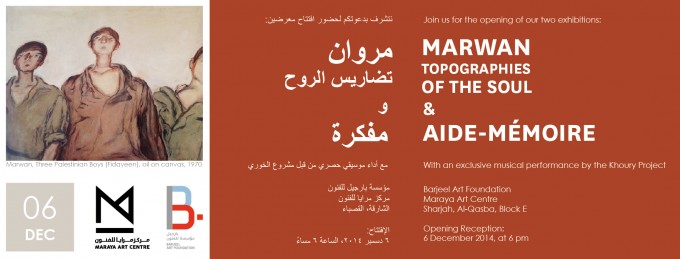
17 November 2014
Two Exhibitions: Marwan Kassab-Bachi and aide-mémoire
Marwan: Topographies of the Soul
Born in Damascus in 1934, Marwan Kassab-Bachi is a Syrian artist living and working in Berlin. He has been actively practicing since the 1950s and is particularly well known for his unique depictions of human figures and faces. In some instances they are well-articulated representations of individuals with distinct features, while at other times, individual traits are abstracted, turning faces into anonymous masks.
This exhibition, being the very first one in the GCC to showcase a range of Marwan’s work within a single venue, aims to introduce the regional public to the varied spectrum of Marwan’s oeuvre. Here, visitors are able to see the artist’s large-scale oil on canvas paintings, aquarelle works on paper, as well as etchings and quick sketches executed in pencil. The show presents portraits derived from life, political subjects, stylized representations of figures, and includes several depictions of masks and inanimate objects.
Marwan’s official website: www.marwan-art.com
aide-mémoire
Taking notes is a common activity applicable to numerous sets of circumstances. We usually mark them down quite quickly and casually, sometimes to catch a fleeting thought or remind us to of something that needs to be said or done. They can be neat or messy, clear or incoherent, hand written or typed. Sometimes orderly and often chaotic, notes inevitably capture momentary observations and reflections that we seek to preserve at times unsuccessfully, for future reference.
The manner in which notes are recorded is unique to each note taker. Our exhibition entitled aide-mémoire, a French term that translates as an aid to memory often pertaining to notes, presents a collection of photographs, videos and sculptures that can elicit subjective responses from spectators. Many of the artists in this exhibition reference memories that are personal or collective, showing how they can be recorded or fictionalised through aesthetic creation. A spectator’s response to a work of art often takes place in a moment of solitude when they first encounter a piece. By encouraging passive observation, many modern-day museum settings can typically leave the observer’s reaction to go unrecorded. We invite visitors to this exhibition to capture in one word or more on the notepads provided their immediate responses to some or all of the art objects they encounter.